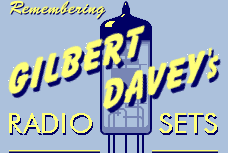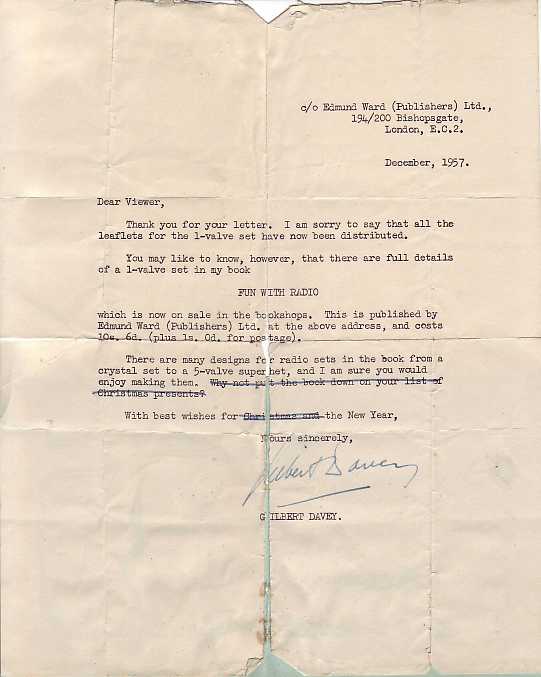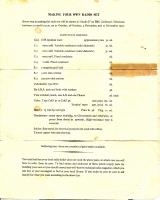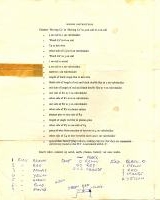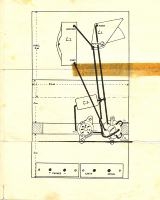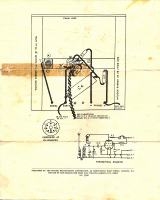
|

|

|

|

|

|

|

|

|

|

|

|

|

|

|

|
Hover your mouse over the
navigation buttons above for
brief page contents.
Pages marked > give access to
one or more subsidiary pages -
see also Site Map at bottom
of WELCOME page.
|
|
|
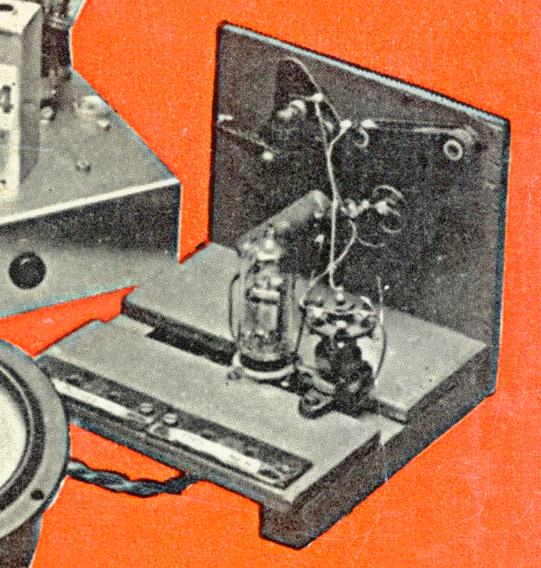
|
|
Clearly a Studio ‘E’ prototype, with Teletron coil
and large grid capacitor, positioned and wired
as shown in the leaflet. Note the long socket strips screwed
through to the side runners.
Image from dust jacket of Fun with Radio, 4th edition, 1965
(enlarged and enhanced).
Site author's copy. With acknowledgments to Claire Davey.
Other rights may subsist.
|
A Davey Studio ‘E’ prototype
This image, a little over 1 1/2 inches tall, appears as part of a photo-montage on the
dust-jacket of Fun with Radio, 4th edition (1965), but there is no reference to the image
within the book, which contains the usual (inverted tray) version of the Beginner's One-Valver.
This is clearly a Studio ‘E’ prototype, and the resemblance to the drawings in
the BBC leaflet (see below) is so striking that it is tempting to think that this image is of either
the prototype that served as the basis for the drawings, or possibly the set that Gilbert Davey
built in the studio during the live broadcasts. It shows a Teletron
coil and large grid capacitor, positioned and wired as in the leaflet, and long (2-inch?) terminal
strips secured at their outer ends with wood screws as the leaflet suggests.
We now know that Davey built three examples of the set before or during the broadcast series - see
Studio ‘E’ under fire!.)
General points
A high proportion of those 26,000 leaflets probably only survived
a few months or years before being destroyed. It needs more of
a sense of history to preserve such ephemera than most children - or even
adults - have. So three cheers to Doug Brown for preserving his
copy! Who knows how many other copies remain hidden away,
forgotten by those that possess them?
The leaflet is a single sheet, 16 inches x 10 inches, folded at the centre
to form a four-page leaflet 8 inches by 10. Doug Brown's copy (images
accessible below) is torn, disfigured with Sellotape adhesive and other
stains, and carries his uncle's notes on the resistor colour code. The
scans are unretouched, entirely legible, and full of character!
The relevant editions of the Radio Times show that the series was
broadcast in six parts, the first aired on 30 September 1957. After a
two-week pause, five more parts followed from 21 October to 18 November.
The leaflet itself, no doubt prepared some time in advance, states that
the series was to be in four parts commencing on 21 October and concluding on
11 November.
The Radio Times listings are undoubtedly correct, as it was - and
still is - printed and distributed very shortly in advance in order to reflect
last-minute schedule decisions. These listings are borne out by the
programme scripts preserved by Gilbert Davey, and allow us to make a good guess
at the content of each part of the series - see
The Studio ‘E’ Scripts.
|
